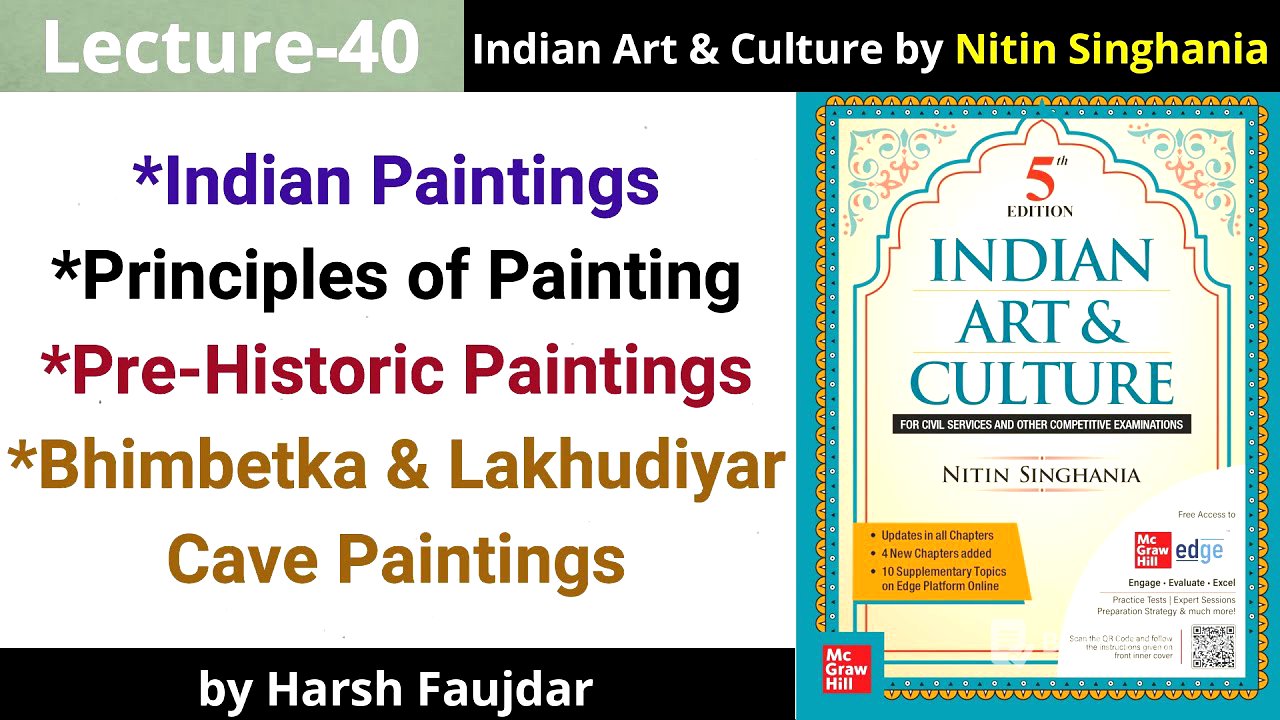TLDR;
This video provides an overview of Indian paintings, focusing on their principles, prehistoric examples, and specific cave paintings like Bhimbetka and Lakh Udayar. It covers the evolution of painting from ancient times to the influence of the Gupta age, the principles of painting as described in the Kamasutra, and the characteristics of prehistoric paintings across different periods (Upper Paleolithic, Mesolithic, and Chalcolithic).
- Principles of painting and their evolution through ages.
- Pre-historic paintings and their characteristics.
- Bhimbetka and Lakh Udiyar Cave Paintings.
Introduction to Indian Paintings [0:00]
The history of Indian paintings can be traced back to ancient and medieval periods, with illustrations in books and the emergence of miniature styles dominating the Mughal and Rajput courts. The arrival of Europeans brought Western influences to the art of painting. The chapter will explore the progression and changes in the art of painting through different phases.
Principles of Painting [2:32]
The history of paintings in India can be traced back to primitive rock paintings in places like Bhimbetka, Mirzapur, and Panchmani. Painted pottery during the Indus Valley Civilization also contributed, but the real birth of painting in India occurred during the Gupta Age. In the 3rd century AD, Vatsyayana's Kamasutra outlined six main principles (Shadangas) of Indian art: Roop Bhed (difference in form), Pramana (proportion), Bhava (expression), Lavanya Yojanam (aesthetic composition), Sadrisyam (similarity), and Varnika Bhanga (use of colors and brushes). References to painting are also found in Brahminical and Buddhist literature, with examples like Lapa Chitra (representation of myths on textiles), article (incorporation of lines and drawings), Dhuli Chitra (paintings on the floor), and Pat Chitra (paintings on cloth and palm leaves). Vishakha Dutt's play Mudrakasha mentions various paintings and styles, including Chowk Pitaka (isolated framed drawings), Dighal Pita (long scrolls of paintings), and Yam Pita (isolated paintings).
Pre-Historic Paintings [13:52]
Pre-historic paintings were typically executed on rocks, with engravings called petroglyphs. Rock paintings were first discovered in India in 1867-68 by Archie Bald, while the earliest pre-historic paintings were found in Bhimbetka Caves in 1957. These paintings are categorized into three major phases: the Upper Paleolithic period (40,000 to 10,000 BC), the Mesolithic period (10,000 to 4,000 BC), and the Chalcolithic period.
Upper Paleolithic Period [17:21]
During the Upper Paleolithic period, rock shelter caves with walls made of quartzite were common. Ochre was the most commonly used mineral for painting, mixed with lime and water to produce various colors. White, dark red, and green colors were used to depict large animals, while red color was used for hunters and green color for dancers and human figurines.
Mesolithic Period [19:58]
In the Mesolithic period (10,000 to 4,000 BC), red color was mainly used in paintings, which were comparatively smaller in size. Common subjects included group hunting, grazing, and riding.
Chalcolithic Period [21:39]
The Chalcolithic period (2500 to 700 BC) saw the use of green and yellow colors. Paintings from this period often depicted battle scenes with men riding horses and elephants, as well as figures holding bows and arrows. Samples of paintings and writings from this period are found in Ashokan and Gupta Brahmi scripts, indicating that people inhabited the caves from the Ashokan to the Gupta periods. In Narsinghgarh, Madhya Pradesh, paintings show skins of spotted deer left for drawing, suggesting that humans had perfected the art of tanning skins for shelter and clothing. The Jogi Marg cave site in the Ramgarh Hills of Chhattisgarh contains paintings from the later Chalcolithic period, dating back to around 1000 BC. Other sites in Chhattisgarh, such as the Koriya district (Godsar and Kohabor rock art sites) and the Durg district (Chitwa Dongri), also feature paintings from this period. Early cave paintings are also found in Orissa (Guda Handi and Yogi Mata rock shelters) and Telangana (Kup Galu).
Bhimbetka Cave Paintings [29:26]
Located in Madhya Pradesh, the Bhimbetka cave paintings were granted UNESCO World Heritage Site status in 2003. Discovered by V. S. Wakankar, the oldest paintings are believed to be about 3000 years old. The paintings show a continuous evolution from 1 lakh BC to 1000 AD, belonging to the Upper Paleolithic, Mesolithic, Chalcolithic, and early historic and medieval periods, with most paintings from the Mesolithic age. These paintings depict everyday life, social life, community life, and various animals, along with geometric designs and symbols. Other important sites for early cave paintings include Bellary, Panchmarhi, Rajgarh, and Tenmalai.
Lakh Udiyar Cave Paintings [33:12]
The term "Lakh Udiyar" literally means "1 lakh caves." These cave paintings are a group of historical paintings located in the Almora district of Uttarakhand, on the banks of the Suyal River. The paintings primarily depict humans, animals, and weapons used by early humans, created with fingers using red, white, and black colors. In 2020, two more similar paintings were discovered near Almora.









